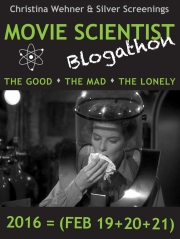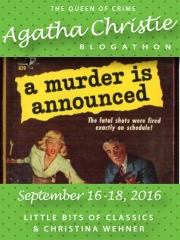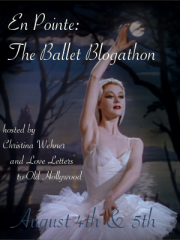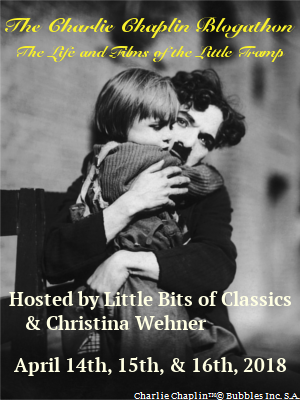 Ever since reading FictonFan’s and Silverscreening’s reviews of Alfred Hitchcock’s The Lodger, I have been doubly curious to see the film, which is also my contribution to Coffee, Classics, & Craziness’ “The Alfred Hitchcock Blogathon 2017.” It was the third film that Alfred Hitchcock directed, but is the one that he considered essentially his first film, the first to be recognizably Hitchcockian.
Ever since reading FictonFan’s and Silverscreening’s reviews of Alfred Hitchcock’s The Lodger, I have been doubly curious to see the film, which is also my contribution to Coffee, Classics, & Craziness’ “The Alfred Hitchcock Blogathon 2017.” It was the third film that Alfred Hitchcock directed, but is the one that he considered essentially his first film, the first to be recognizably Hitchcockian.
The Lodger is one of many film and stage adaptations of the novel by Marie Belloc Loundes, published in 1911 and inspired by the Jack the Ripper murders in 1888. Hitchcock’s film, however, appears to be set in 1927, though there is a definite gaslight and Gothic ethos. Ivor Novello, who plays the mysterious lodger, would have made a fantastic Dracula, actually.
The film opens with a silent scream.
Neil Brand, who wrote the contemporary score for the version I saw, has the orchestra scream along with the image. The scream reminded me of Hitchcock’s later close-up image of Janet Leigh screaming in the shower in Psycho. The beginning of The Lodger is really excellent and demonstrates Hitchcock’s visual skill, which requires minimal inter titles to explain the action. A blonde girl (Hitchcock already demonstrating his preference for blonds) has been murdered. There is one witness, who says she saw a tall man with a scarf wrapped around the lower half of his face. We see the police, the curious spectators, the ghoulish interest, the press, everything in a rapid fire of images (including a brief glimpse of Hitchcock). We also see a sign for a show called “Golden Curls.” The image of the sign will show up mockingly throughout the film.
The story then shifts to Mrs. Bunting (Marie Ault), her husband (Arthur Chesney), their daughter Daisy (June Tripp…who has golden curls), and the boyfriend/policeman Joe (Malcolm Keen). Joe and Daisy flirt with a heart-shaped cookie cutter and some dough, once again demonstrating Hitchcock’s flair for visual storytelling. Into this tranquil and domestic scene comes…the Lodger! Who looks like Dracula, or at the very least his cousin.
The lodger is definitely a strange young man, who doesn’t like pictures of women with golden curls in his room and has a habit of looking tormented by some inner turmoil. Not to mention pacing restlessly in his room, which is shown with a glass floor that shows him walking while the Buntings look up at the ceiling, the visuals of his footsteps almost making us “hear” the sound of his footsteps that the Buntings actually hear. When the lodger’s not looking creepy, he looks like Lord Byron, all sensitivity and anguish.
The tension in the film comes from Mrs. Bunting and her husband beginning to suspect that their lodger is the mysterious killer after he sneaked out at night and was gone during the time when another golden-curled woman was murdered. Their anxiety is heightened when he shows a strong interest in Daisy, who does not see anything wrong in the lodger’s behavior. Joe, on the other hand, grows increasingly jealous.
It’s quite an exciting, atmospheric film and really shows Hitchcock’s ability to create tension visually rather than via words, as well as hitting on a number of themes that he would explore later. And if you have never seen it, I would definitely recommend watching it before reading the spoilers section below.
(Spoilers) I have to admit that I knew the surprise ending before coming into the film, that the lodger is actually, incontrovertibly innocent (unlike Laird Cregar’s lodger in the 1944 film), but I was curious how it would play out. The lodger’s innocence had a rather odd affect, I thought, somewhat like the affect of Hitchcock’s later Suspicion, though far less egregious. It makes Ivor Novello’s performance both sinister and romantic, which makes him a creepy lover. At one moment, he is stalking Daisy to her job as a model and buying her the dress she was modeling (it’s obvious that he’s a well-off young man, socially far above Daisy) and another moment gazing soulfully into her eyes like a young man with bad case of puppy love. In fact, the second part of the film feels more like a romance than a mystery or thriller.
I also have to admit that my view of the characters is somewhat colored by the fact that about two-thirds of the way through the movie, my sister labeled the two romantic leads as “pretty ninnies.” This is partly because the plot is not consistent. If he’s innocent, why didn’t he go to the police? Why did he run? Why is she standing by him, even though she knows nothing about it. They do not behave rationally. But they certainly look pretty while their doing it…especially Novello.
It is interesting to note that never again would Hitchcock have a woman place such unreasoning faith in a man for no reason. In The 39 Steps, Madeleine Carroll initially tries to turn Robert Donat in, Eva Marie Saint “helps” Cary Grant because she’s really working for the villain, Grace Kelly is simply turned on by the fact that she believes Cary Grant is a criminal in To Catch a Thief, and in Sabateur Priscilla Lane also initially tries to turn Robert Cummings in.
Regarding the ending, however, I’ve noticed that there is a theory floating around on the internet about another possible interpretation of the end of the film, which jives with my own impressions. Perhaps he really is the killer after all! Hitchcock originally meant to have the ending be ambiguous, but when Ivor Novello was cast, he was forced to change the script so that the leading man (rather like Cary Grant in Suspicion) would be innocent. But quite a few questions go unanswered. Like who killed the lodger’s sister and why? His sister was the first victim, but she died in the middle of a ballroom when the lights are turned off. Whoever killed her had to be someone in upper class society. But her murder doesn’t fit with all the other murders that come after, which seem to be happening in the street. Which makes one wonder if the lodger really killed his sister and went on a mad spree afterwards, until he saw Daisy, who perhaps reminded him of his sister.
It’s just a theory, but it seems odd that Hitchcock would make the lodger’s mansion look so creepy and Gothic. I half expected him to greet Daisy and her parents by saying, “I am…Dracula.” And then when they embrace, we can see the sign “To Night – Golden Curls” blinking in the background. Is it meant to be portentous of what is to come? Evidently, Neil Brand, the composer, thought so because as the lodger and Daisy embrace, the music grows gradually more ominous. Hmm.

Why is the sign “To Night Golden Curls” blinking in the background? Is that meant to be ironic or prophetic?
This post is my contribution to “The Alfred Hitchcock Blogathon 2017.” Be sure to check out the other posts, which can be found here.



























